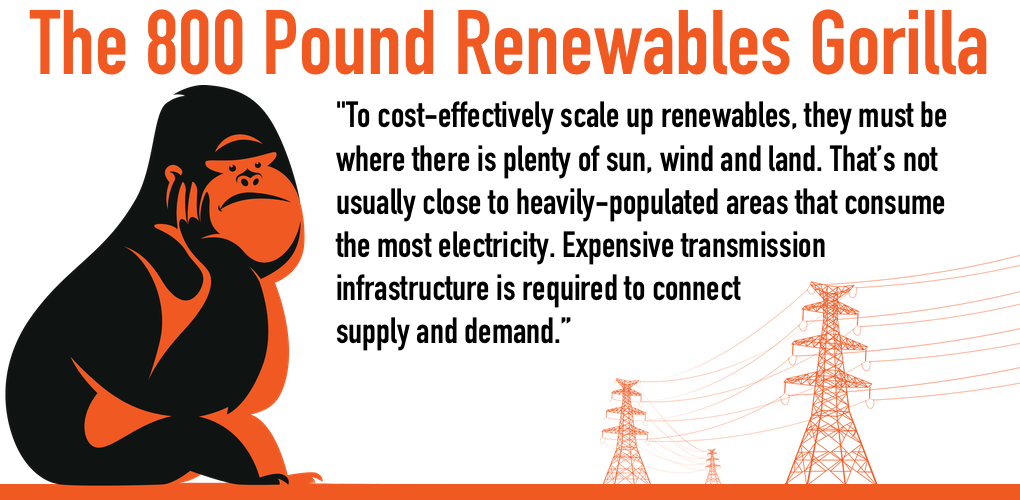
When Down is Up
The reduction in the price of electricity from solar and wind power over the last decade has made for a fantastic story. But it’s hiding a more complex and troubling truth. While the price of generating power from renewables has fallen, the cost, or burden, of integrating these intermittent sources of power onto the grid is growing and it’s already showing up in higher electricity bills.
What many fail to understand is that the cost of generating power is only a portion of what influences the cost of electricity – in fact, less than half. Non-fuel costs, such as transmission and distribution, have a greater influence on your electricity bill. And transmission is perhaps the most obvious example of where renewables are driving up the cost of power.
As Brian Murray, Director of the Duke University Energy Initiative, recently wrote in Forbes, “To cost-effectively scale up renewables, they must be sited where they are most productive – in places with plenty of sun, wind and land. That is typically not close to the population centers where users locate, so more transmission infrastructure is required to connect supply and demand. This may be having an effect on system costs. Between 2012 and 2017, when non-hydro renewables generation grew by 77 percent, transmission costs rose by 50 percent.”
While Murray cautions that we shouldn’t attribute all of this jump in transmission costs to renewables, their growth is the 800-pound gorilla in the room.
Building new multi-state transmission projects – needed to, for example, move wind generation from the Great Plains to major cities – is a remarkably difficult and expensive undertaking. Projects of this variety regularly require 10 years or more for development, approval and construction. Many never make it across the finish line. Murray cites the Competitive Renewable Energy Zone project in Texas as an example. That effort alone to connect wind generation in the Texas’ panhandle to population centers in the middle of the state cost $7 billion. And yet, that steep price tag barely hints at the costs to come.
As renewable portfolio standards have grown more ambitious, the percentage of renewable power on the grid has shot up to about 10 percent of U.S. electricity generation. While the system costs of integrating this amount of variable power have started to build, particularly in states with larger amounts of renewables – such as Texas with its high reliance on wind or California with its growing reliance on solar power – we haven’t even scratched the surface of just how expensive integrating these sources of power can be.
According to the National Renewable Energy Lab, when we cross the 30% threshold of variable power on the grid, we see serious system disruption and the cost of managing the deepening gulf between the peaks and valleys of variable generation gets really expensive. While we aren’t there yet, that’s the trajectory we are on. A majority of states have renewable portfolio standards. Multiple states are aiming for 100% renewable power or something close to it. Higher concentrations of renewables will require massive transmission investment just to balance the grid and ensure reliability.
In high-renewable scenarios, when the weather doesn’t cooperate in one region of the country, grid operators will need to shift excess power from another region to fill the gap. That’s not possible with the grid we have. As Wood Mackenzie recently projected, the Green New Deal would necessitate the construction of another 200,000 miles of high-voltage transmission lines. The current grid would, for all intents and purposes, need to be completely rebuilt. The cost and complexity of doing so is staggering. $4.5 trillion worth of staggering – or about $35,000 per household – estimates Wood Mackenzie to implement just the bare bones of the Green New Deal. And while some may shrug off those extraordinary costs, they may feel differently when they realize they will be paying those costs in their utility bill – utility bills that we know one third of Americans already struggle to pay.
The U.S. isn’t the only country where building new transmission is a bear. Germany, which is known for its engineering prowess, is pursuing its own Green New Deal-lite and has found building a new transmission network to accommodate its growing penetration of wind and solar power to be a nightmare. Peter Altmaier, Germany’s minister of the economy and energy, has called the effort a “catastrophe.”
Unfortunately, we are not having an honest conversation about the complexity, difficulty and cost of moving to a grid largely supplied by intermittent renewable power. The low-hanging fruit of integrating renewables onto the U.S. electricity system is quickly disappearing. It’s only going to get much harder and more expensive from here on out. The challenges to grid reliability and affordability are immense and all too real.
The narrative of the falling cost of wind and solar power is a captivating one. It has reoriented the thinking of many about the art of the possible. But like a lot of good stories, it’s hardly a full accounting of the facts.
- On August 7, 2019
